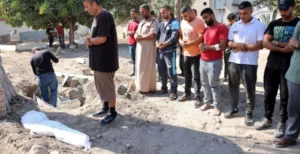The Tipping Point: Understanding the Israel-Hamas Struggle and Its Ramifications
Explore the ongoing Israel-Hamas conflict’s effects on Lebanon and the region, including insights on key players and recent developments.
Escalating Tensions: The Israel-Hamas Conflict and Its Regional Ramifications
The ongoing conflict between Israel and Hamas has intensified dramatically since the surprise attacks on October 7, 2023. These events have not only led to a significant loss of life but have also raised concerns about regional stability, particularly in Lebanon, where Hezbollah’s involvement complicates the situation further. This article explores the current state of affairs, key players, and the broader implications of this conflict.


The Background of the Conflict
The recent escalation began with a coordinated attack by Hamas militants from Gaza, resulting in approximately 1,200 deaths, primarily among Israeli civilians. This unprecedented assault prompted a fierce military response from Israel, which has since launched extensive airstrikes across Gaza.
The Israeli military claims that over 42,000 Palestinians have died as a result of these retaliatory strikes, although these figures encompass both combatants and civilians.
In Lebanon, Hezbollah has emerged as a significant player in this conflict. Following Hamas’s initial attack, Hezbollah began firing rockets into northern Israel. Israel’s military response has included ground operations aimed at dismantling Hezbollah’s infrastructure, particularly its extensive network of tunnels used for launching attacks.
Key DevelopmentsRecent developments have further escalated tensions:
- Hezbollah’s Tunnel Network: Israeli forces have uncovered a sophisticated tunnel system in southern Lebanon, which they believe is integral to Hezbollah’s military strategy against Israel. This network is equipped with weapons caches and rocket launchers, posing a direct threat to Israeli communities near the border.
- Death of Hamas Leader Yahya Sinwar:
 In a significant blow to Hamas, Israeli forces reported the killing of Yahya Sinwar, a key figure behind the October 7 attacks. His death is expected to impact Hamas’s operational capabilities and leadership structure.
In a significant blow to Hamas, Israeli forces reported the killing of Yahya Sinwar, a key figure behind the October 7 attacks. His death is expected to impact Hamas’s operational capabilities and leadership structure. - International Reactions: The conflict has drawn widespread international attention and condemnation. Human rights organizations have criticized both parties for their actions, particularly regarding civilian casualties and freedom of expression. Reports indicate that journalists in Gaza face severe restrictions and threats to their safety while covering the conflict.
Humanitarian Impact
The humanitarian situation in Gaza is dire. The ongoing airstrikes have devastated infrastructure, leading to shortages of food, water, and medical supplies. The United Nations has warned that the humanitarian crisis could worsen if immediate action is not taken to provide aid to those affected by the conflict.
In Lebanon, the influx of displaced persons has strained resources and heightened tensions within communities already grappling with economic challenges. The Lebanese government faces increasing pressure to manage this crisis while maintaining stability amid rising sectarian tensions.


The Role of International Actors
The international community’s response to the Israel-Hamas conflict has been mixed. While some nations have condemned Hamas’s actions and supported Israel’s right to defend itself, others have criticized Israel for its disproportionate use of force in Gaza.
The United States has reaffirmed its support for Israel but has also urged restraint to prevent further civilian casualties. Meanwhile, countries in the Arab world are increasingly vocal about their support for Palestinian rights, leading to protests and calls for action against perceived injustices in Gaza.
Conclusion
The Israel-Hamas conflict continues to evolve with profound implications for regional stability and humanitarian conditions. As both sides prepare for potential escalations, it is crucial for international actors to engage constructively in seeking a resolution that prioritizes human rights and addresses the underlying issues fueling this long-standing conflict.
